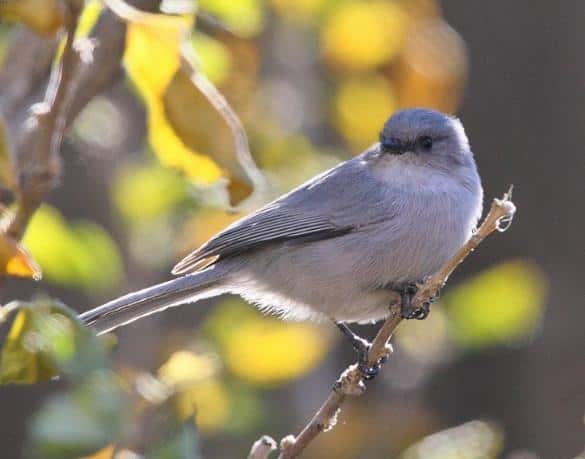 A Bushtit is among the declining species. Photo by Bob Walker
A Bushtit is among the declining species. Photo by Bob Walker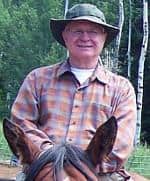 Amateur Naturalist: What is Happening to the Birds?
Amateur Naturalist: What is Happening to the Birds?By ROBERT DRYJA
We are considering what is happening to the birds of Los Alamos. This has involved reviewing the different kinds of habitats throughout the county.
Annual data for individual species as well as groupsof species is available from 1989 to the present, or 30 years.
We had considered species of birds t in a prior article that are generalists when it comes to preferred habitats for nesting. Most bird species nest primarily in one kind of habitat. Ducks for example nest in ponds and marshy habitats, not at the top of mountains in mature forest. Generalists in contrast can be found nesting in most habitats. The data shows these generalists as a group have been increasing in number from year to year.
However the averages for the group as a whole are not copied by individual species. The Evening grosbeak dominates the counts, representing nearly 1,700 of the 2,700 counted.
The increase from year to year primarily reflects what is happening to the evening grosbeak. The other species have remained approximately the same or have followed a slow cycle over the decades for an increase and then decrease.
We will now consider a second group. This group includes birds associated with the juniper/pinyon habitat area for their nesting preference. The juniper/pinyon habitat is primarily in the eastern side of Los Alamos County at a lower elevation toward the Rio Grande. There are ten species associated with this habitat. CHART A shows that the House finch is the dominant species, representing approximately 1,500 of the 2,900 birds counted.
The ten species that nest in the juniper/pinyon have remained at approximately the same count from year to year when considered as a group.
Approximately 90 to 100 are counted from year to year, based on the statistical trend line. There are three years (2006-2008) in which an irruption occurs. This irruption is due to the house finch increasing from 51 counted in 2006 to 175 in 2008. It then declines to a similar level as in earlier years.
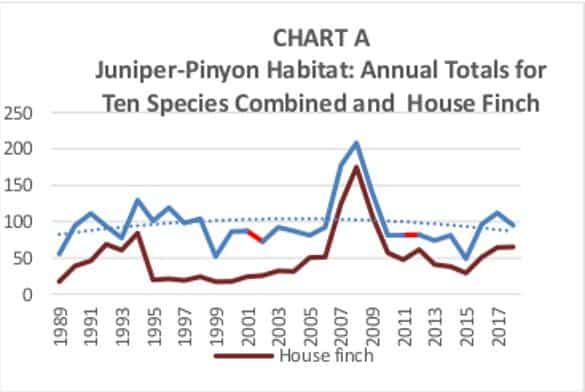
A downward trend appears when the House Finch count is excluded. CHART B shows the annual count moves from a high count of 98 in 1997 to a low of 20 in 2015 for the nine species, excluding the house finch. CHART C shows an even more distinctive downward pattern when the seven least common species are considered. There is an irruption from 1993 to 1997 when the annual count increases from 5 to 31. However, the count then declines to again be similar to the early 1990’s.
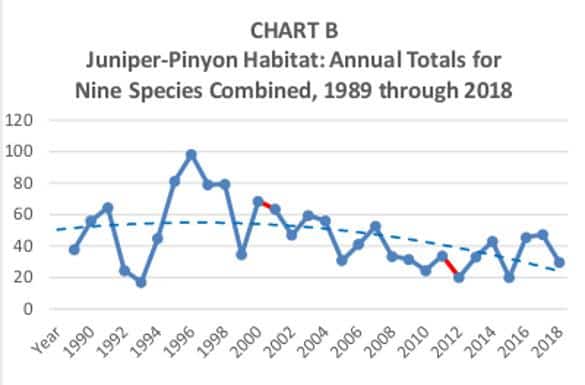
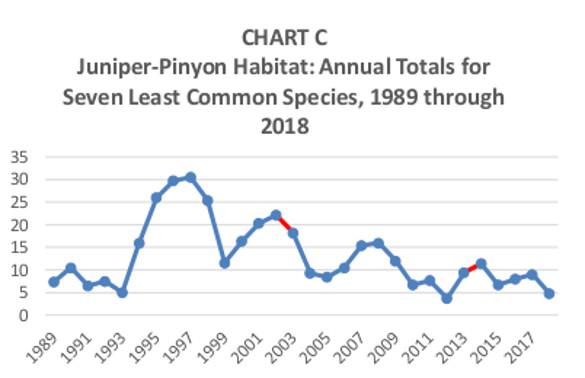
What has occurred in the juniper/pinyon habitat so that house finches peaked in 2008 and the seven least common species peaked in 1997? Were forest fires the source for declines? The red sections of the trend lines in the charts indicate the year after the forest fires in 2000 and 2011. CHART A shows the peak for counting House finches occurred in years in between the forest fires. CHART C shows the
peak for the seven least common species occurred in 1998. The decline continues after the two forest fires, approaching zero. What else may be contributing to the decline of species?
Droughts vary in their intensity and length of time. Plants may be dry and grow slowly during a relatively mild drought lasts only a few weeks but a severe draught is life threatening. Bark beetles can burrow under the bark of ponderosa pine trees during a severe drought. The trees then are weakened or killed. Bird species that associate with pine or conifer forest may decline due to the loss of this habitat.
A severe drought may last over a year. Five droughts in the severe range have occurred in Los Alamos County since 2000. One of these droughts lasted for 91 weeks or nearly two years. The decline of the seven species shown in CHART B clearly starts in 2002, the same time when the first severe drought occurs. A total of 180 weeks, or 3 ½ years, of severe draught have occurred in the past nineteen years. Forest fires and droughts together may be contributing to the decline of species that already are uncommon.

To summarize, the overall annual counts of birds in the Juniper-Pinyon Habitat area of Los Alamos Canyon have remained relatively constant for the past 29 years. However, this is due the house finch being the overwhelmingly dominant specie. The House finch evidently is adaptable to draught conditions and changes in the kinds of trees present. Eight of the nine other species in contrast have been declining in numbers. Indeed, seven of these species are approaching extinction locally. Species diversity is decreasing.
The Bushtit and Woodhouse scrub jay are the two species that are intermediate between the seven least common species and the house finch.
Chart D shows these two species combined. They also have declined since 1997 but not as completely when compared to the seven least common species. Approximately 20 to 40 have been seen annually in recent years compared to the 5 to 10 annually for the least commonly seen species.
The Canyon towhee is among the seven least commonly seen species. However it is following a different trend. CHART D shows that typically 4-12 have been counted annually from 1989 to 2005. The count now has increased to 14-16 annually for the three most recent years. This change stands out when compared to the combined count for the bushtit and woodhouse jay. There are 6 Canyon towhees counted in 1996 compared to 73 for the Bushtit and Woodhouse jay. The combined species are twelve times more common. This difference nearly ends by 2018 when 16 Canyon tohwees are counted compared to 18 for the two combined species. Why is one rarely seen species becoming less rare while another eight species are decreasing?

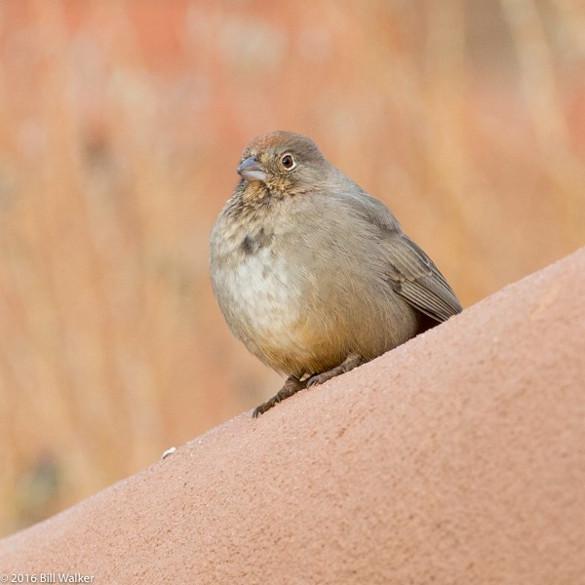 A Canyon towhee. The dark spot on its chest helps to identify it. Photo by Bob Walker
A Canyon towhee. The dark spot on its chest helps to identify it. Photo by Bob Walker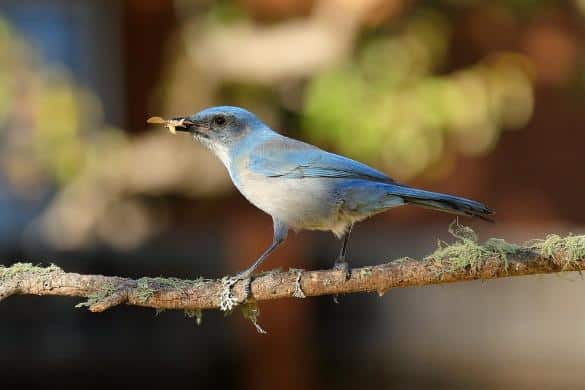 A Woodhouse scrub jay with a meal in its beak. Photo by Bob Walker
A Woodhouse scrub jay with a meal in its beak. Photo by Bob Walker
